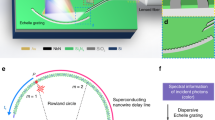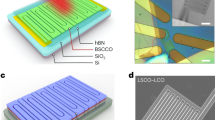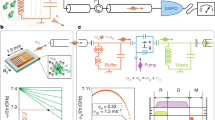Abstract
The far-infrared region (wavelengths in the range 10?µm–1?mm) is one of the richest areas of spectroscopic research1, encompassing the rotational spectra of molecules and vibrational spectra of solids, liquids and gases. But studies in this spectral region are hampered by the absence of sensitive detectors2,3,4,5—despite recent efforts to improve superconducting bolometers6, attainable sensitivities are currently far below the level of single-photon detection. This is in marked contrast to the visible and near-infrared regions (wavelengths shorter than about 1.5?µm), in which single-photon counting is possible using photomultiplier tubes. Here we report the detection of single far-infrared photons in the wavelength range 175–210?µm (6.0–7.1?meV), using a single-electron transistor consisting of a semiconductor quantum dot in high magnetic field. We detect, with a time resolution of a millisecond, an incident flux of 0.1 photons per second on an effective detector area of 0.1?mm2—a sensitivity that exceeds previously reported values by a factor of more than 104. The sensitivity is a consequence of the unconventional detection mechanism, in which one absorbed photon leads to a current of 106–1012 electrons through the quantum dot. By contrast, mechanisms of conventional detectors2,3,4,5,6 or photon assisted tunnelling7 in single-electron transistors produce only a few electrons per incident photon.
This is a preview of subscription content, access via your institution
Access options
Subscribe to this journal
Receive 51 print issues and online access
$199.00 per year
only $3.90 per issue
Buy this article
- Purchase on Springer Link
- Instant access to full article PDF
Prices may be subject to local taxes which are calculated during checkout




Similar content being viewed by others
References
van Dishoeck, E. F. & Helmich, F. P. Scientific drivers for future high-resolution far-infrared spectroscopy in space. Proc. Eur. Space Agency Symp. 388, 3– 12 (1996).
Fujiwara, M. & Hiromoto, N. Ge:Ga far infrared photoconductor with a low Ga concentration of 1 × 1014?cm-3. Jpn J. Appl. Phys. 36, 4262– 4266 (1997).
Kawamura, J. et al. Low-noise NbN lattice-cooled superconducting hot-electron bolometric mixers at submillimeter wavelengths. Appl. Phys. Lett. 70, 1619–1621 ( 1997).
Tucker, J. R. & Feldman, M. J. Quantum detection at millimeter wavelengths. Rev. Mod. Phys. 57, 1055– 1113 (1985).
Richards, P. L. Bolometers for infrared and millimeter waves. J. Appl. Phys. 76, 1–24 (1994).
Schoelkopf, R. J., Moseley, S. H., Stahle, C. M., Wahlgreen, P. & Delsing, P. A concept for a submillimeter-wave single-photon counter. IEEE Trans. Appl. Supercond. 9, 2935–2939 (1999).
Kouwenhoven, L. P. et al. in Mesoscopic Electron Transport (eds Sohn, L. L. et al.) 105–214 (Kluwer Academic, Dordrecht, The Netherlands, 1997).
van der Vaart, N. C. et al. Time-resolved tunneling in the quantum Hall regime. Phys. Rev. B 55, 9746–9756 (1997).
Kawano, Y., Hisanaga, Y. & Komiyama, S. Cyclotron emission from quantized Hall devices: injection of nonequilibrium electrons from contacts. Phys. Rev. B 59, 12537–12546 (1999).
Gornik, E. et al. Fourier transform spectroscopy of Landau radiation in n-InSb. Infrared Phys. 16, 285– 291 (1976).
Bollweg, K. et al. Detection of compressible and incompressible states in quantum dots and antidots by FIR-spectroscopy. Phys. Rev. Lett. 76, 2774–2777 ( 1996).
Stopa, M., Bird, J. P., Ishibashi, K., Aoyagi, Y. & Sugano, T. Giant backscattering magnetoresistance resonance and Quantum Dot electronic structure. Phys. Rev. Lett. 76, 2145–2148 (1996).
Schoelkopf, R. J., Wahlgreen, P., Kozhevnikov, A. A., Delsing, P. & Prober, D. E. The radio-frequency single-electron transistor (RF-SET): a fast and ultrasensitive electrometer. Science 280, 1238–1241 ( 1998).
Averin, D. V. & Likharev, K. K. Coulomb blockade of single-electron tunneling, and coherent oscillations in small tunnel junctions. J. Low Temp. Phys. 62, 345–373 (1986).
Acknowledgements
We thank D. Austing and M. Stopa for helpful discussion. This work was supported by the Core Research for Evolutional Science and Technology (CREST) of the Japan Science and Technology Corporation (JST).
Author information
Authors and Affiliations
Corresponding author
Rights and permissions
About this article
Cite this article
Komiyama, S., Astafiev, O., Antonov, V. et al. A single-photon detector in the far-infrared range. Nature 403, 405–407 (2000). https://doi.org/10.1038/35000166
Received:
Accepted:
Issue Date:
DOI: https://doi.org/10.1038/35000166
This article is cited by
-
Determination of exciton binding energy using photocurrent spectroscopy of Ge quantum-dot single-hole transistors under CW pumping
Scientific Reports (2023)
-
Quantum NETwork: from theory to practice
Science China Information Sciences (2023)
-
Compact Remote Spectral Terahertz Imager
Journal of Infrared, Millimeter, and Terahertz Waves (2022)
-
Plasmonic semiconductor nanogroove array enhanced broad spectral band millimetre and terahertz wave detection
Light: Science & Applications (2021)
-
Axion/hidden-photon dark matter conversion into condensed matter axion
Journal of High Energy Physics (2021)
Comments
By submitting a comment you agree to abide by our Terms and Community Guidelines. If you find something abusive or that does not comply with our terms or guidelines please flag it as inappropriate.



